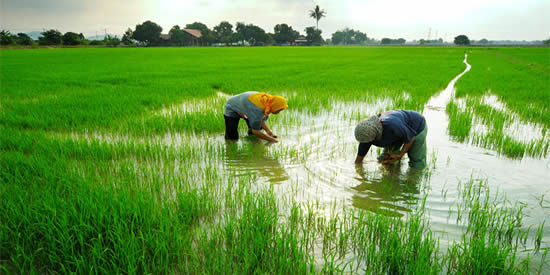| BlueSky Business Aviation News | |||||||||||||||||||
| . | |||||||||||||||||||
For the Buddhists, this set the atmosphere to empower the grain of rice with supernatural nourishment. Rice is the food of alms throughout Asia, and is also considered a wholesome food. Rice is embedded in many cultures and many cuisines. Don’t you just love tidbits of knowledge? I thought rice would be a good topic for an article because of a simple innocent question asked to me by a crew member recently: Once the rice is cooked, does it have to be refrigerated? Uncooked rice kernels can contain spores of Bacillus cereus, a bacterium that can cause food poisoning. When the rice is cooked (any variety, any method), these spores survive. They are not killed by heat or cold. If the rice is left standing at room temperature, the spores can grow into bacteria. These bacteria will multiply and may produce toxins (poisons) that cause vomiting or diarrhea. The longer cooked rice is left at room temperature, the more likely it is that the bacteria or toxins could make the rice unsafe to eat. Rice is an excellent source of carbohydrates for passengers and crew to be served on the aircraft as long as you consider these safety precautions:
Even with the mitigated risks associated with possible mishandling (because now you know the correct way to order and handle rice), I believe that it is offset by its benefits. Eating carbohydrate-rich rice means having more energy. Rice has a low Glycemic Index (GI), breaking down slowly in your body, and releasing glucose gradually into the bloodstream which is the perfect carb for the diabetic passenger in moderation. It is a completely satisfying food; it reduces 'between-meal' hunger pangs and gives you more energy during the day. This would be an excellent choice for a starch on a long flight where sustained energy is required. All rice contains carbohydrates, protein, trace amounts of fats and sodium and are all gluten free. Whole grain rice contains more protein, fiber, vitamins and minerals than white rice and the colored varieties boast more anti-oxidants. A quarter cup of wild rice has 30 times more antioxidant power than white rice. Some people are unable to tolerate the proteins found in wheat, barley, rye, oats and triticale (gluten allergies and celiac disease). If these passengers and crew consume these foods, they can feel unwell, and those few with celiac disease can get very sick. All rice is gluten free, making it the essential choice for people with that dietary requirement. Rice has the following nutritional benefits:
In addition to all of these health benefits, rice is versatile; it can be used in everything from a salad, to an entrée to a side dish to a dessert. Here is a bit of trivia for you to store away for the day when you need to know what rice to order and why. The shape and length of the rice kernels determines the texture and potential use when cooked, and the type of cuisine it is used for. There are more than 40,000 varieties of rice that grow on every continent except on Antarctica, all fall into 3 types . . . long grained, medium grained and short grained. After rice has been fully cooked, each grain of rice swells to three times in original weight. Simple, right? Long grain rice, cooks light and fluffy, falls apart and the kernels are separate when cooked. This type is used for pilafs, stuffing, rice salads and jambalaya. Medium grained rice is moist and tender and commonly used for risotto and paella. Short grained rice, has rounder shorter kernels which upon cooking becomes moist and sticky making it a great option for rice puddings, desserts and for eating with chopsticks.
When ordering catering, it is important to specify the type of rice you want with your meal. There are so many varieties that this item is one food that will fall into the "if you don’t tell me, then I get to choose” group. Don’t let your food source determine the type and preparation method of the rice you order. Several of the most popular rice’s out there at the moment are; Black rice . . . also referred to as “forbidden” (sounds sexy, doesn’t it?) or purple rice is a very dark hue and has high anthocyanin content. It comes in short and long grained. We use this rice to make a dramatic statement on the plate…to offset the light color of a piece of fish or chicken or pork. Red rice is very high in antioxidants because of its varying shades of red. The long grain is from Thailand, medium grain from Bhutan. It has a nutty chewy texture and is good used in salads, stuffing’s, rice bowls and pilafs. We purchase an African Red Rice and blend it with lentils and assorted other rice’s for a rice side dish which adds great color and that necessary “crunch” to an aircraft meal. Wild Rice is native to the Minnesota Indians in North America. It really isn’t a rice at all, but a semi-aquatic grass. The kernels are long and slender, have a nutty flavor, somewhat musty aroma, and actually contain more protein than either brown or white rice. Here, we use pure unmixed wild rice to be served with game, and will blend its strong flavor with bulgur wheat, brown rice and other rice varieties for a pilaf. I think that unmixed wild rice is a taste that many find hard to enjoy with delicate flavors of fish, and chicken. It tends to pair well with beef, game, venison, and other stronger flavor meats. Pure wild rice, unmixed can be costly. Basmati has been in the catering kitchen for years. I love Basmati rice. It is an aromatic long grain rice grown in India, Bangladesh and Pakistan. It is available in brown and white varieties. It’s distinct flavor and aroma produce a soft, tender, fluffy texture and grains do not stick together. It is very often used with curries, and stir fries. I was first introduced to this rice years ago from a flight attendant returning from a trip oversees. She and I searched and searched for it until, I was able to purchase it via mail order. Wow, how times have changed! Brown rice is an all-purpose rice…long grain, medium grain and short grain. If keeping track of fiber servings, a half cup serving of brown rice equals 1 whole grain serving of your daily nutritional requirements. Brown rice contains more selenium, magnesium, and fiber than any enriched white rice. It is commonly eaten in sushi and breakfast cereals. Arborio is a high starch rice that comes in short and medium grained that becomes creamy during the cooking process which makes it perfect for Risotto. (Carnaroli and Vialone Nano are two other rice varieties used to makes risotto) Because this rice is starchy, it works wonderful for puddings and desserts. One of our chef’s makes a delicious, rich, creamy and thick rice pudding where he dusts the top with fresh grated cinnamon, YUM! Jasmine Rice is originally from Thailand. Like Jasmine tea, this rice has a distinctive floral aroma and nutty flavor that seems to pair best with Thai and Mediterranean foods. It is light, tender, and fluffy and can be purchased in brown rice as well. Steaming this rice provides the best results, rather than the traditional boiling. Our basic and most commonly used rice is white rice. White rice tends to be the fall back item when rice is ordered unless a specific variety is requested. The US enriches most white rice with Thiamine, niacin, iron and folic acid. The added nutrients are on the surface of the kernel, so request that the rice is not rinsed before or after cooking to retain the nutrients. As you sit with rice of some type in front of you in the near future, here are some fun tidbits of trivia to think about.
Let me introduce myself . . . My name is Paula Kraft and I am founder and President of Tastefully Yours Catering, an aviation specific caterer, located in Atlanta, Georgia for over 35 years.
Currently I am an active member of the NBAA Flight Attendant Committee Advisory Board and the NBAA International Flight Attendant Committee, Women in Corporate Aviation, Women in Aviation International, National Association of Catering Executives, International Flight Catering Association, the International Food Service Association and the International Caterer’s Association. I have coordinated training programs and clinics for NBAA, EBAA and BA-Meetup conference attendees for over 10 years, created mentoring programs for caterers and flight attendants to broaden their aviation culinary skills, and to assist them in adapting to the unique challenges and constraints found in catering for general aviation. I recognize the need for training and have worked closely with flight departments, flight crews, schedulers and customer service reps at the FBOs to ensure that catering specific training provides information and skills necessary to reduce risk while assisting them in their job duties that include safe food handling, catering security, accurate transmission of food orders, and safe food production, packaging and delivery. I fell into aviation catering quite by accident. I was the in-house caterer and bakery supplier for Macy’s department stores in Atlanta when catering was ordered for a Macy’s customer which was soon to change my life. After the client enjoyed the catering provided, I was summoned to the client’s corporate office to provide several of the items delivered through Macy’s to the executive dining room. Within a week, I was providing food for the flight department and my first order was for the President of a foreign country (as I was too be told soon after). So, here I am, some 35 years later, still loving every minute of every day in aviation catering.
|
|||||||||||||||||||



